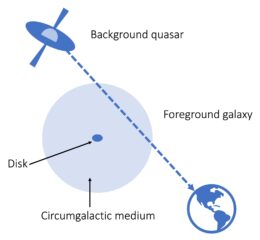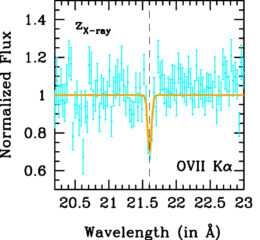Galaxies seem to have less matter than they should. Has the missing matter been found at last in the form of hot, sparse gas?
The Troubling Matter of Normal Matter

The space surrounding a galaxy isn’t empty. Instead, it’s filled with tenuous circumgalactic gas invisible to optical telescopes. [NASA, ESA, CXC, SSC, and STScI; CC BY 4.0]
Researchers suspect that the matter isn’t really “missing” but is instead “hidden,” present in a form that’s hard to observe. Recently, a major breakthrough happened when researchers zoomed out from the luminous, starry disks of galaxies to study the tenuous gas of the circumgalactic medium. There, they found immense reservoirs of cool (~104K) gas accounting for as much as 50% of the lost matter. In a recent article, researchers have turned up the heat on the search, seeking out a second, hotter (~106K) component of the circumgalactic medium.

A diagram (not to scale!) of the observing setup. X-rays emitted by the quasar pass through the circumgalactic medium of a foreground galaxy. [Kerry Hensley/AAS Nova]
A Critical Alignment
A team led by Fabrizio Nicastro (Italian National Institute for Astrophysics) aimed to track down the remaining missing matter by observing the light from quasars as it passes through galaxies in the foreground. Quasars are the luminous centers of distant galaxies that are powered by supermassive black holes consuming matter. Superheated disks surrounding these active black holes emit enormous amounts of X-rays. As these X-rays travel from the quasar to our telescopes, they can be intercepted by galaxies along their path. If the sought-after hot gas is present in the surroundings of these galaxies, it’ll make itself known by absorbing some of the quasars’ X-ray light.
Nicastro and collaborators analyzed X-ray spectra of three quasars whose lines of sight pass through the circumgalactic medium of a foreground galaxy. None of the individual quasar spectra showed definitive signs of the elusive hot circumgalactic gas, but a signal emerged when the team combined observations of all three quasars. Using several different fitting methods and ways of combining the data, the team detected a signal at a significance ranging from 4.2 to 6.8 sigma.
Missing Mass Found

Example of an X-ray absorption line identified after stacking the observations from all three quasars. [Adapted from Nicastro et al. 2023]
The discovery of this supply of hot circumgalactic gas has significance beyond solving the missing matter problem: the newfound detection of hot gas can also tell us about how galaxies have exchanged gas with the circumgalactic medium throughout their lives.
Citation
“X-ray Detection of the Galaxy’s Missing Baryons in the Circumgalactic Medium of L* Galaxies,” Fabrizio Nicastro et al 2023 ApJL 955 L21. doi:10.3847/2041-8213/acec70

